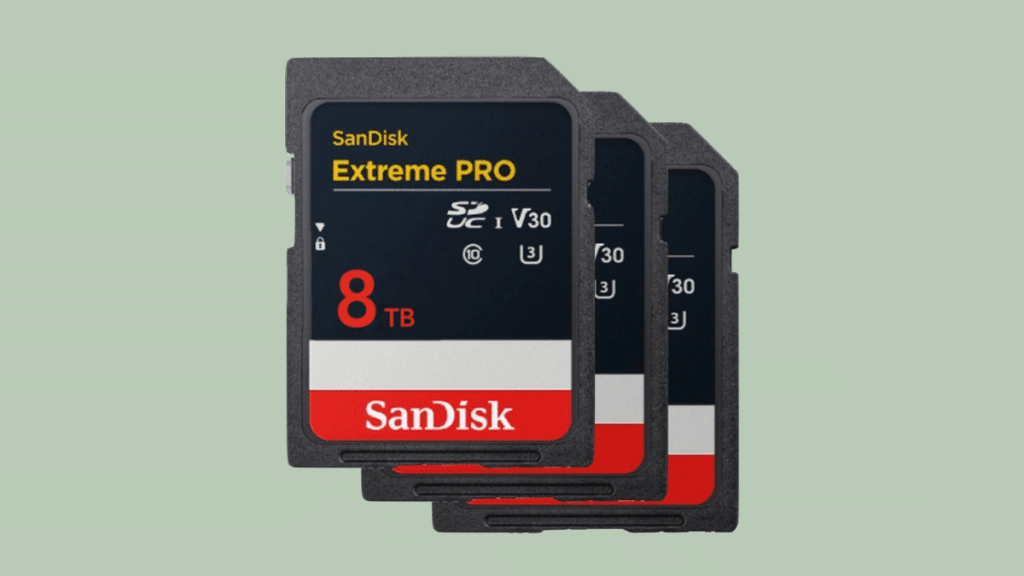You can lose critical files on your SanDisk SD card for any reason. When that happens, most people are likely to go searching for tools to recover files from SanDisk SD card. However, not every software is credible, though, and any improperly chosen one may do even more harm or render a recovery impossible.
It is also very important to go with the right recovery procedure so as to increase your success rate. In this guide, we’ll share the causes of SanDisk SD card data loss and provide several tips to improve recovery chances. We’ll also guide you to rescue your files with top tools, and what to do when software fails to reclaim files.
Part 1: Common Scenarios of SanDisk SD Card Data Loss
You might lose data from a SanDisk SD card due to the following frequent scenarios:
- Files are removed or the card is formatted by mistake.
- Removing the card without safely ejecting can corrupt the file system.
- File system corruption caused by power loss, malware, or interrupted transfers, making the card unreadable.
- Water, heat, bending, or dirt can damage the card and cause failures.
- A virus or malware can erase, encrypt, or corrupt files when using infected devices.
- Using the card in different devices may cause formatting conflicts.
- Counterfeit SanDisk cards often fail early due to poor components.
Part 2: Tips to Improve SanDisk SD Card Data Recovery Results
Whether you’re restoring your SanDisk SD card from a backup or using recovery software, a few simple tips can help you get better recovery results. Have a look at them:
- Remove the SanDisk card immediately to avoid overwriting lost data.
- Enable read-only mode or make a disk image before starting recovery.
- Check the SD card for any signs or symptoms of physical damage.
- Save recovered files to a different device, and not the same SD card.
- If the card is undetected or damaged, use a recovery service.
- Do not format the SD card even if your computer asks to.
- Keep your card reader and SD card firmware up to date.
Part 3: How to Recover Files From a SanDisk SD Card Easily and Quickly?
The following are the 5 best SanDisk file recovery software to retrieve data from SanDisk cards, with step-by-step instructions to use each tool:
Option A: Tenorshare 4DDiG
4DDiG Data Recovery is a beginner-friendly tool that can retrieve lost, hidden, or deleted files from various storage devices. With a success rate of 98.64%, 4DDiG has become one of the most highly praised SanDisk file recovery software solutions in the industry. Here’s more information about Tenorshare 4DDiG:
- This program can recognize more than 2,000 file types, including photos, videos, documents, etc.
- The app can extract files lost due to crashes, missing partitions, viruses, or system errors.
- It lets you preview rescued files by their type and path.
- You can export recovered files to your computer or cloud storage.
- It provides a free version for Windows users.
- It can help you recover files from SanDisk SD card in just 3 simple steps.
Here’s how to recover deleted photos from SanDisk memory card and other file types with this tool:
Step 1: Connect your SanDisk memory card to your computer for access. Then, execute the recovery tool on the same computer.
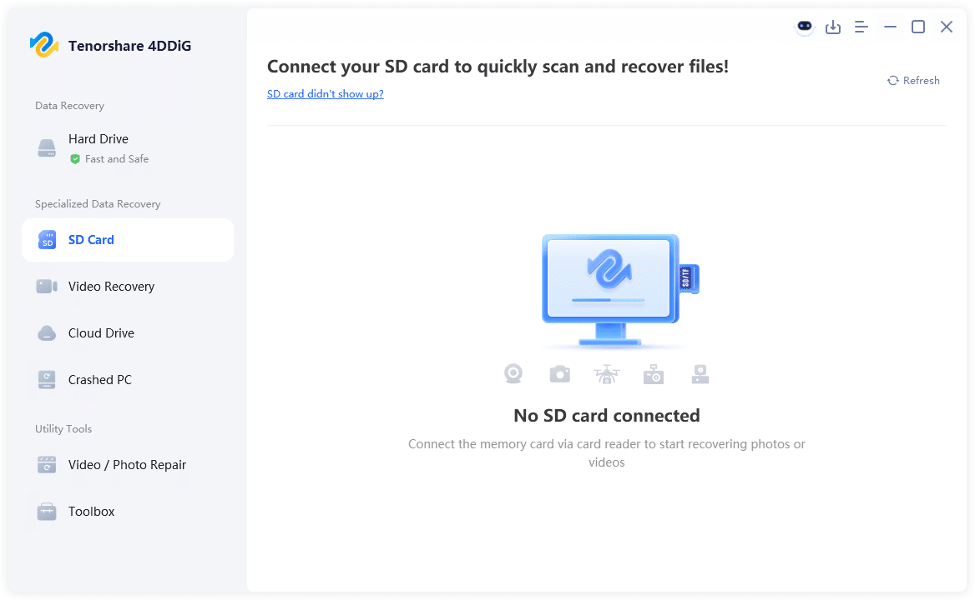
Step 2: Choose the SanDisk card once it’s recognized by the tool. Pick your desired file types to scan. Tap “Scan.”
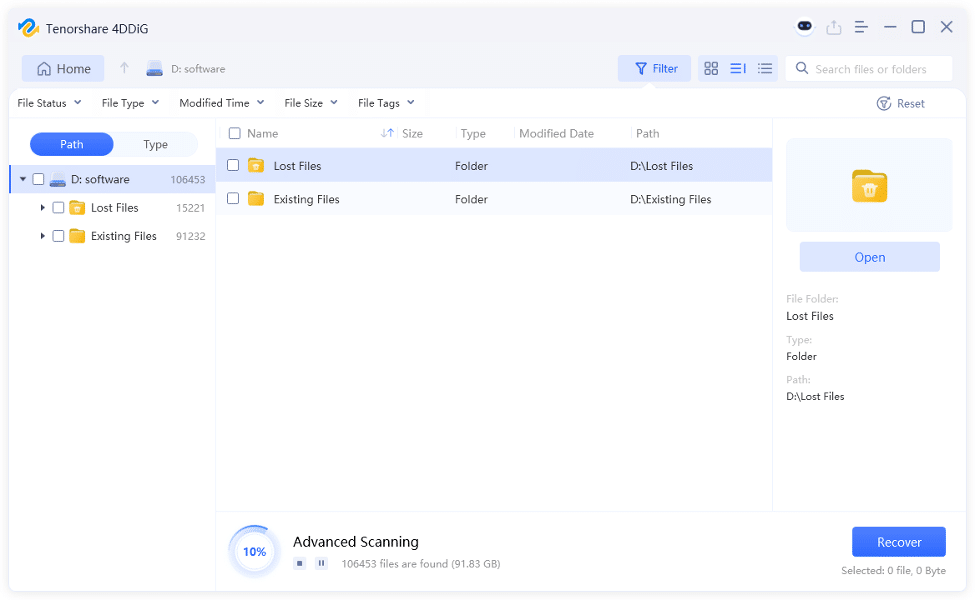
Step 3: Pause or stop the scan once you recover files. Adjust the filter tags and input keywords to find exact files. Examine results by their type and path.
Step 4: Hit “Recover” to export recovered files to your computer or cloud drive.
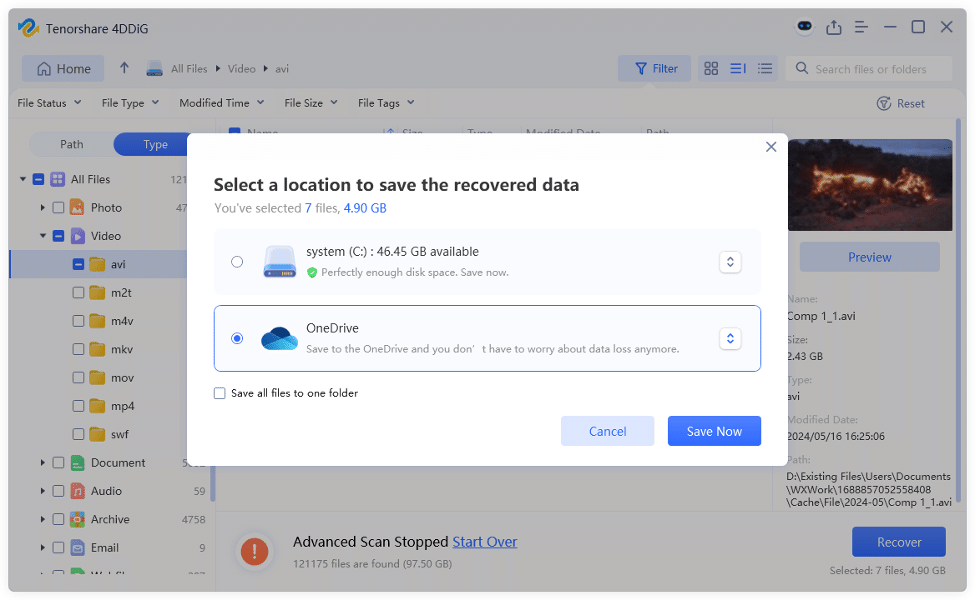
Option B: RescuePRO
RescuePRO is created specifically to recover files from SanDisk SD card and other SanDisk products. If you have just bought a SanDisk card, you will usually find a one-year free trial license for RescuePRO inside the package. This powerful tool has a simple, easy-to-use interface, enable the preview of files, and can create a backup. Plus, it supports both Windows and Mac and can recover files as large as 1 TB. Here’s an example of using RescuePRO Deluxe SanDisk file recovery software:
Step 1: Visit the site to download RescuePR. Install and execute the tool on your computer. Activate it with the license number given with your SanDisk card.
Step 2: Connect your SanDisk card to your computer for access. Then, select “Photo Image Recovery.” Choose your SD card. Hit “Start.”
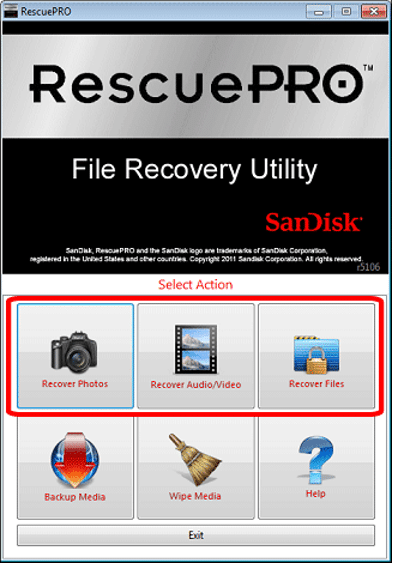
Step 2: Once you find your files, preview them. Next, click “Output Folder” to open the save location (inside the “Documents” folder).
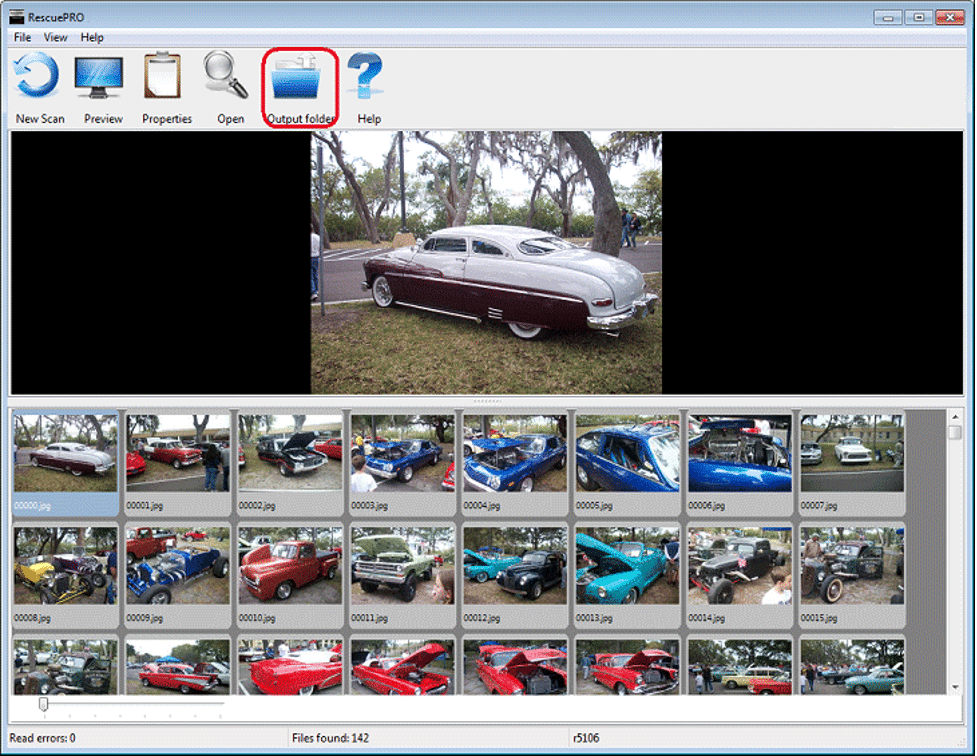
Option C: Recuva
Recuva by Priform is a powerful SanDisk SD card recovery tool to restore damaged and formatted photos, videos, documents, emails, and more from SD cards and other media. It offers a deep scan mode for thorough searches, file previews before recovery, and secure overwrite options to permanently erase data.
It’s compatible with FAT, NTFS, and exFAT file systems and can also recover from BitLocker-encrypted drives with a password. Here’s how to recover deleted photos from SanDisk memory card and other files:
Step 1: Connect your SanDisk card to your computer for access. Open “Recuva.” Then, choose the file type you want to recover (or select “All Files”). Hit “Next.”
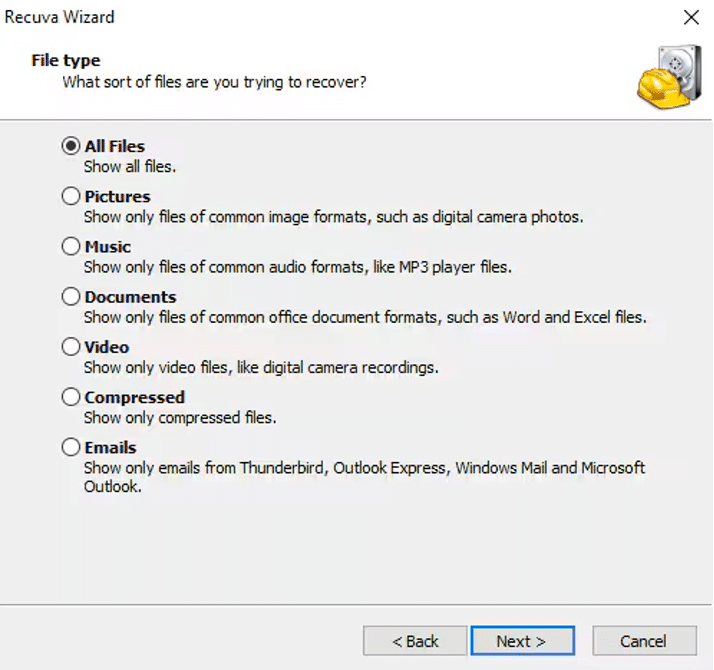
Step 2: Select the location where the files were lost. Tap “Next” again. Click “Start” to scan the selected drive.
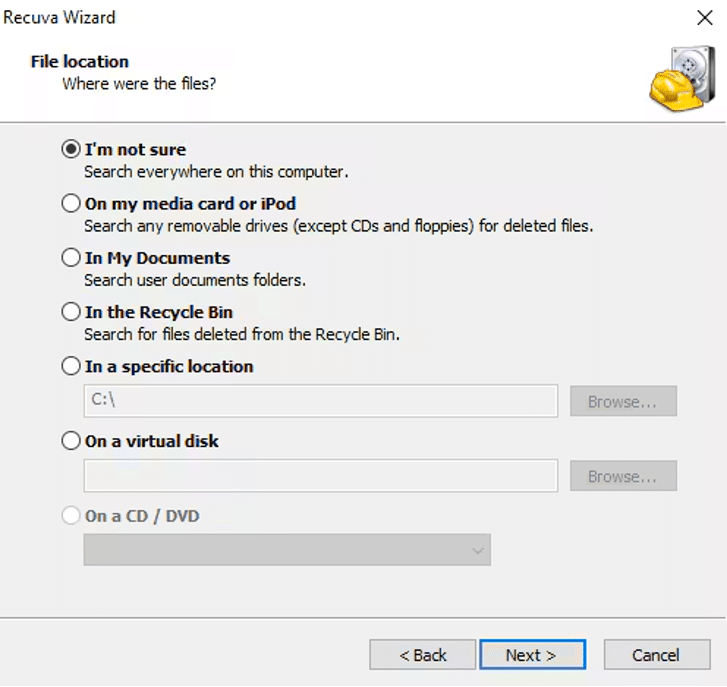
Step 3: Preview files in “Advanced Mode.” Choose what you want. Tap “Recover.”
Step 4: Choose a save location. Hit “OK.” Wait for the recovery to finish.
Option D: PhotoRec
PhotoRec is a free, open-source SanDisk SD card recovery tool that supports Windows, macOS, Linux, and more, supporting 500+ file formats. The tool employs deep scan and file carving, even if the file system is corrupted. However, it doesn’t restore original filenames or folder structure and has no file preview option. Here’s how to recover deleted photos from SanDisk memory card with PhotoRec:
Step 1: Connect your SanDisk card to your computer for access. Then, open Photorec on your computer.
Step 2: Select your SD card from the list with the arrow keys, e.g., /dev/disk[drive letter]. Then, choose its partition.
Step 3: Pick “Other” as the file system type. Then, select “Free” or “Whole” scan.
Step 4: Select a folder to save recovered files (.. is up one directory, and . represents the current directory).
Step 5: Start the scan after choosing the directory (after you press C), and wait for the recovered files to appear.
Option E: Windows File Recovery
Windows File Recovery is a free command-line tool for Windows 10/11 that can recover SanDisk SD card. It supports the recovery of various formats and offers different recovery modes. Regular (fast for recent NTFS deletions), Extensive (deep scan for corrupted/formatted drives), Segment (for damaged NTFS), and Signature (recovers by file type but loses names/folders).
However, there’s no GUI or file preview, and it doesn’t perform well in complex data loss scenarios. Here’s an example of using Windows File Recovery’s Signature Mode to recover SanDisk SD card:
Step 1: Download the Windows Recovery tool from the Microsoft Store. Then, connect your SanDisk card to your computer for access.
Step 2: Execute the tool. Run the following command if you want to find multiple file types such as JPEGs, PDFs, and ZIP files:
- winfr E: D: /x /y:JPEG,PDF,ZIP (Here E is the SanDisk card and D is the drive where you wish to save recovered files).
Step 3: To check the list of supported file types, execute the command winfr /#.
Part 4: What to Do If SanDisk File Recovery Software Fails?
If SanDisk card recovery software can’t restore your files, it may be due to physical damage, severe file system corruption, overwritten data, firmware issues, or encryption. Therefore, consider sending it to a professional SD card recovery service. But before that, stop using the card immediately, test it on another device, and check if it’s detected.
Record error messages and securely put the card in an anti-static bag. Then, check out Secure Data Recovery, DriveSavers, Ontrack, or PITS data recovery services. These firms specialize in SD card recovery and provide a free evaluation. Your SanDisk card recovery can cost anywhere between $100-$300 to deal with logical failures, or $300-$1000+ in the case of physical damage, and can take 3-7 days in most cases.
Final Words
SanDisk SD card data can be lost due to deletion, corruption, damage, or malware. But acting fast, by stopping card use, picking trusted recovery software, and using both quick and deep scans, improves recovery chances. While tools like RescuePRO, Recuva, PhotoRec, and Windows File Recovery do their job well, 4DDiG Data Recovery is a top choice to recover files from SanDisk SD card.
